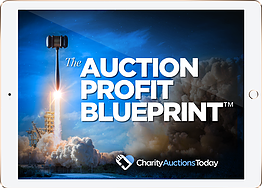DOWNLOAD The Auction Profit Blueprint
The 4 tools BIG organizations use every time to skyrocket auction profits!
The Step-By-Step Guide to stop leaving thousands on the table.
Learn how to get donors with tips from CharityAuctionsToday. While many resources discuss keeping donors, you may be wondering how to find them in the first place.

Finding donors is essential for the success and sustainability of any nonprofit organization. Especially if you’re a small charity, securing financial support requires strategic outreach, relationship-building, and effective communication.
But how to get donors when you’re just starting out?
Understanding where to look for potential donors, how to engage them, and how to cultivate long-term support can make a significant impact on your fundraising efforts. In this article, we’ll explore practical strategies to help you identify and connect with the right donors for your cause.
This article will guide you through practical steps to enhance your donor attraction efforts, helping you secure the support necessary to achieve your mission.
Effective donor research is essential for identifying potential donors, businesses, and foundations that are most likely to support your nonprofit’s mission. By gathering insights on donor interests, giving capacity, and philanthropic history, you can tailor your outreach strategies and build meaningful relationships.
The key to successful donor research is using the right tools and methods to analyze potential supporters and engage them in a way that resonates with their values.
The first step in donor research is leveraging internal data. Review your existing donor database (Even if it’s small!) to identify patterns in giving history, donation frequency, and engagement levels. Look for major donors, recurring supporters, and lapsed donors who may be re-engaged with the right approach. Understanding who has given in the past and why can provide valuable clues about how to attract new donors with similar interests.
Next, consider using external resources to expand your donor research. Wealth screening tools, prospect research databases, and publicly available financial records can help you assess a donor’s capacity to give.
Additionally, social media and networking platforms like LinkedIn can offer insights into potential donors’ professional backgrounds, interests, and affiliations with other charitable organizations. By analyzing this information, you can personalize your outreach and demonstrate how supporting your cause aligns with their philanthropic goals.
Finally, engage with your current network and community to uncover new donor opportunities. Board members, volunteers, and existing donors can provide introductions and referrals to potential supporters. Hosting networking events, surveys, or informal meetings can also help you learn more about what motivates donors to give.
By combining data-driven research with relationship-building efforts, nonprofits can develop a well-rounded strategy to identify, engage, and retain the right donors for long-term support
There are various tools available to assist with donor prospect research. These tools can range from simple donor databases to sophisticated software that aggregates data from multiple sources. Utilizing these tools can provide valuable insights into potential donors, helping you prioritize who to approach.
Once you’ve identified potential donors, crafting a compelling message is essential. Your message should clearly articulate your mission, the impact of donations, and why support is needed. This will resonate with potential donors and motivate them to contribute.
A strong message should include the following elements:
Building relationships with potential donors is a critical component of attracting support. Personal connections can make potential donors feel valued and more inclined to contribute to your cause.
In today’s digital age, leveraging online platforms can significantly enhance your donor attraction efforts. Social media, email campaigns, and your organization’s website are powerful tools to reach a broader audience.
Social media platforms like Facebook, Twitter, and Instagram allow you to share your story and engage with potential donors on a personal level. Use these platforms to post updates, share success stories, and interact with your audience.
Email campaigns are an effective way to reach potential donors directly. Ensure your emails are well-crafted, concise, and include a clear call to action. Segment your email list to tailor messages to different donor groups.
Your website is often the first point of contact for potential donors, especially your donation page. Ensure it is easy to navigate, mobile-friendly, and includes clear information about how to donate. Highlight your mission and impact prominently to capture visitors’ interest.

by Masjid Pogung Dalangan, Unsplash
Hosting fundraising events is a traditional yet effective way to attract donors. Events provide an opportunity to showcase your organization and connect with potential supporters in a personal setting. While there are many different creative fundraising events to choose from, below are a few common choices.
Hosting a successful fundraiser requires careful planning, strategic promotion, and strong donor engagement.
Start by setting clear goals, selecting the right type of fundraiser for your audience, and creating a detailed timeline to keep everything on track. Utilize multiple marketing channels, such as social media, email campaigns, and community partnerships, to maximize outreach and attendance.
Engage guests with compelling storytelling, interactive activities, and easy ways to give, whether through online donations, auctions, or peer-to-peer fundraising. Finally, follow up with participants to express gratitude, share the fundraiser’s impact, and build lasting relationships for future support.
To sum up:
Partnering with influencers and other organizations can amplify your reach and attract new donors. Wild Apricot reports that more than half of nonprofits reported working with influencers in 2023 and expects this trend to grow.
Influencers can help spread your message to their followers, while partnerships can provide additional resources and credibility.
Look for organizations and individuals who share similar values and goals. Collaborate on joint initiatives or events to reach a wider audience and leverage each other’s strengths.
Ensure that partnerships are mutually beneficial by clearly defining roles and expectations. Regular communication and collaboration will help maintain a strong relationship and maximize the impact of your combined efforts.
Finally, it’s essential to measure the effectiveness of your donor attraction strategies. Regularly assess your efforts to identify what’s working and what needs improvement. Use data and feedback to adjust your approach and optimize your results.
Collect feedback from donors and prospects to understand their experiences and preferences. Use this information to refine your messaging, outreach, and engagement strategies.
Donor acquisition and cultivation are essential components of a successful fundraising strategy for any nonprofit organization. Acquiring new donors is just the first step in building a sustainable network of support, but it’s the cultivation process that truly solidifies lasting relationships.
By effectively nurturing donors, nonprofits can turn one-time givers into long-term advocates and provide them with meaningful ways to stay engaged and involved.
The key to successful donor cultivation is personalization. Donors want to feel valued and appreciated, and understanding their interests, motivations, and connection to your cause allows you to create tailored experiences that resonate with them.
Regular communication—whether through thank-you notes, impact reports, or invitations to special events—keeps donors informed and connected to the mission. It’s crucial to show them how their contributions make a real difference, reinforcing their decision to support your organization.
Building a culture of transparency is also vital. Donors want to see that their funds are being used effectively and efficiently. Regular updates on the organization’s progress, success stories, and financial transparency build trust and inspire continued giving.
A donor who feels confident that their investment is being used for good is more likely to give again and even encourage others to contribute.
Donor acquisition might bring new supporters into the fold, but it’s cultivation that transforms these supporters into passionate, committed donors who will stand by your organization for years to come.
By focusing on relationship-building, transparency, and personalized engagement, nonprofits can cultivate a community of loyal donors that will help drive their mission forward. With careful planning and attention to each donor’s journey, the foundation for sustained success and impact will be laid for the future.
DOWNLOAD The Auction Profit Blueprint
The 4 tools BIG organizations use every time to skyrocket auction profits!
The Step-By-Step Guide to stop leaving thousands on the table.

